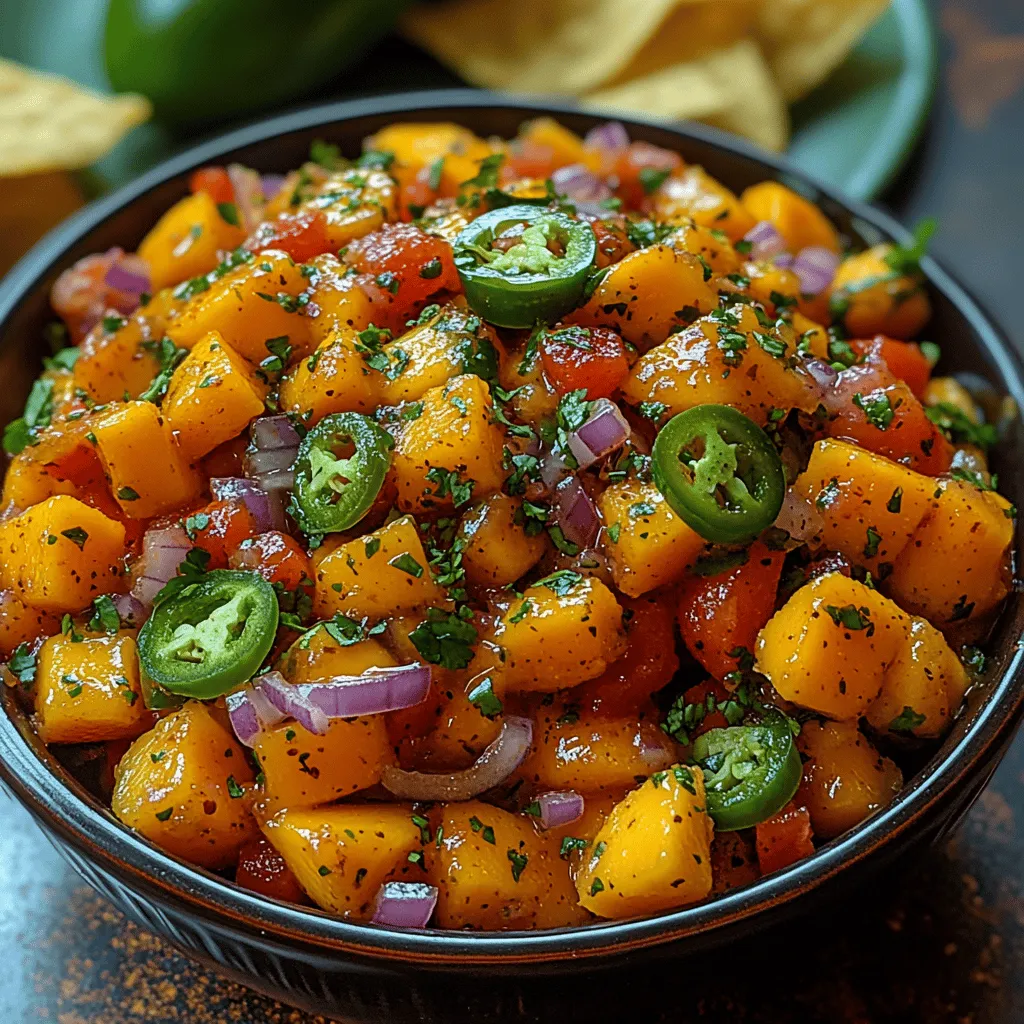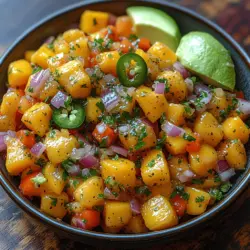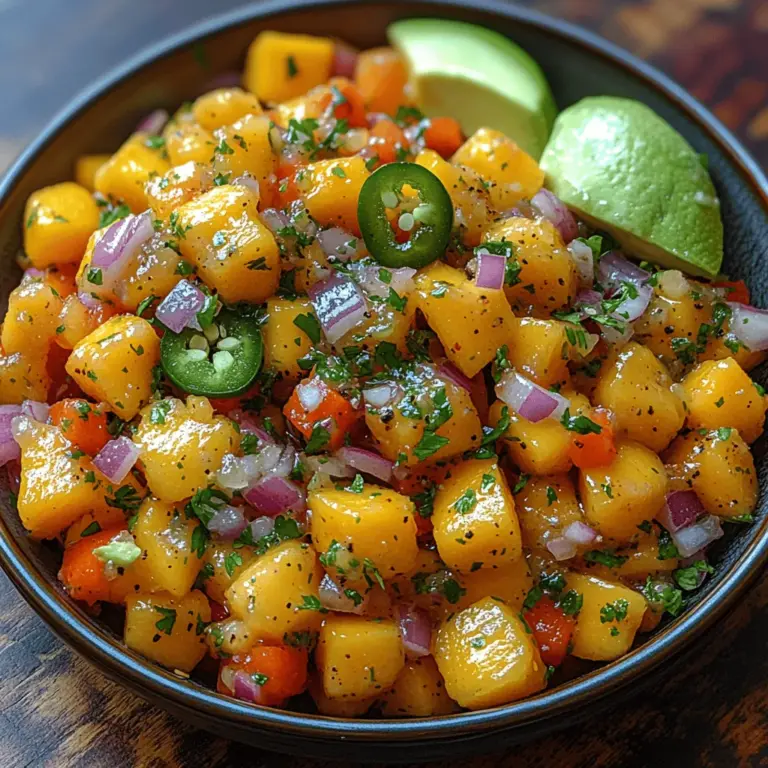When it comes to vibrant, refreshing dips that elevate any meal or gathering, Mango Tango Salsa stands out as a delightful option. This colorful concoction marries the sweetness of ripe mangoes with the zesty kick of jalapeño peppers, creating a salsa that tantalizes the taste buds. The addition of fresh lime juice and cilantro not only enhances the flavor profile but also adds a beautiful brightness to the dish. Whether you’re hosting a summer barbecue, looking for a healthy snack, or simply wanting to add a zesty condiment to your favorite dishes, Mango Tango Salsa is the perfect choice.
The appeal of Mango Tango Salsa lies in its unique fusion of flavors. The luscious sweetness of mangoes balances perfectly with the heat from jalapeños, delivering a taste experience that is both exciting and satisfying. The freshness provided by lime and cilantro rounds out the flavors, making each bite a burst of tropical goodness. This salsa is not only delicious but also incredibly versatile. It pairs wonderfully with grilled chicken or fish, serves as a vibrant topping for tacos, and can even be enjoyed with tortilla chips for a light appetizer.
Understanding the Ingredients: Key Components of Mango Tango Salsa
To create the perfect Mango Tango Salsa, it’s essential to understand the key ingredients that give this dish its distinctive flavor and texture. Each component plays a vital role, contributing to the overall experience of the salsa.
Ripe Mangoes
The star of Mango Tango Salsa is undoubtedly the ripe mangoes. Choosing the right mangoes is crucial to achieving optimal sweetness and flavor. Look for mangoes that are slightly soft to the touch, with a fragrant aroma at the stem end. Varieties such as Haden, Tommy Atkins, or Kent are excellent choices as they offer a balance of sweetness and juiciness. When diced, ripe mangoes provide a luscious, tropical flavor that forms the foundation of this salsa.
Vegetables
In addition to mangoes, a variety of vegetables adds crunch and depth to the salsa. Red onion, jalapeño peppers, and red bell peppers are common choices that create a harmonious blend of textures and flavors. The red onion contributes a mild yet piquant flavor, while the jalapeño adds a spicy kick that can be adjusted based on personal preference. Red bell peppers bring a sweet, crisp element to the mix, complementing the other ingredients beautifully. Together, these vegetables create a colorful and flavorful base for the salsa.
Fresh Herbs
No salsa is complete without fresh herbs, and in Mango Tango Salsa, cilantro is the herb of choice. Cilantro adds a refreshing, slightly citrusy note that elevates the salsa’s overall flavor. It’s important to use fresh cilantro for the best results, as dried herbs will not provide the same vibrancy or taste. If you’re not a fan of cilantro, consider substituting it with fresh parsley, though the flavor profile will change.
Citrus Element
The addition of lime juice is essential for balancing the flavors in Mango Tango Salsa. Lime juice not only enhances the sweetness of the mangoes but also adds a tangy acidity that brightens the dish. Furthermore, the acidity of lime juice helps preserve the freshness of the ingredients, ensuring that the salsa remains vibrant and delicious. When preparing the salsa, be sure to use fresh lime juice rather than bottled, as the latter can lack the brightness and flavor of the real thing.
Optional Additions
While the core ingredients create a fantastic salsa on their own, there are optional additions that can further enhance the flavor and texture. Ground cumin, for instance, can be added for a hint of earthiness, which complements the sweetness of the mango. Avocado is another optional ingredient that can introduce a creamy texture, making the salsa even more indulgent. If you choose to include these optional ingredients, be sure to adjust the quantities based on personal preference to maintain a harmonious flavor balance.
Step-by-Step Guide to Making Mango Tango Salsa
Creating Mango Tango Salsa is a straightforward process, but attention to detail can elevate the final product. Follow this step-by-step guide to ensure your salsa is bursting with flavor and freshness.
Prep the Ingredients
Begin by preparing the mangoes. To properly peel and dice a mango, hold it upright on a cutting board. With a sharp knife, slice down along one side of the pit to remove the flesh. Repeat on the other side, discarding the pit. Once you have the mango halves, use a paring knife to score the flesh in a crosshatch pattern without cutting through the skin. Then, turn the skin inside out, and slice off the diced mango pieces. Repeat for the remaining mangoes until you have the desired quantity.
Chopping Vegetables
Next, it’s time to chop the vegetables. Start with the red onion. Cut off the ends and peel away the outer skin. Halve the onion and place it cut-side down on the board for stability. Slice it into thin strips, then rotate and chop again to achieve small, finely diced pieces. For the jalapeños, cut off the stem and slice them in half lengthwise. Use a spoon to scrape out the seeds if you prefer a milder heat. Then, finely chop the jalapeño into small pieces. For the red bell pepper, remove the stem and seeds, then chop it into small, uniform pieces as well. Uniformity in size is key for an aesthetically pleasing salsa and ensures that all flavors meld together nicely.
Combining Ingredients
Once all your ingredients are prepped, it’s time to combine them. In a large mixing bowl, gently add the diced mango, chopped red onion, jalapeño, and red bell pepper. It’s important to mix the ingredients carefully to avoid mashing the mango. Use a large spoon or spatula to gently fold the ingredients together until evenly distributed.
Adding Lime Juice
Next, add the freshly squeezed lime juice to the mixture. To juice a lime effectively, roll it on the countertop with your palm before cutting. This helps release the juice more easily. Cut the lime in half and use a citrus juicer or your hands to squeeze the juice over the salsa, ensuring that the seeds don’t fall in. Mix the salsa gently again to ensure the lime juice is evenly distributed throughout the ingredients.
Seasoning to Taste
After adding the lime juice, it’s time to season your salsa. Start with a pinch of salt, mixing it in gently. Taste the salsa and adjust the seasoning as needed. If you’re feeling adventurous, consider adding a small amount of ground cumin at this stage for added depth. Remember, the goal is to enhance the natural flavors of the ingredients, so start with a small amount and increase gradually if desired.
Chilling the Salsa
Finally, once your salsa is well mixed and seasoned, it’s best to chill it before serving. Cover the bowl with plastic wrap or transfer the salsa to an airtight container and place it in the refrigerator for at least 30 minutes. Chilling allows the flavors to meld together, creating a more cohesive and flavorful salsa. It also enhances the refreshing quality of the dish, making it an even more enjoyable addition to your meals or gatherings.
By understanding the ingredients and following these detailed steps, you’ll be well on your way to creating a delicious Mango Tango Salsa that will impress your guests and elevate any meal.

Serving Suggestions for Mango Tango Salsa
Mango Tango Salsa is a delightful concoction that not only tantalizes your taste buds but also offers versatile serving options. Here are several creative ways to enjoy this vibrant salsa:
1. With Tortilla Chips: The classic pairing of salsa with tortilla chips remains a favorite for good reason. The crunchiness of the chips complements the sweet and tangy flavor of the salsa, making it the perfect appetizer for parties or casual get-togethers.
2. As a Topping for Grilled Proteins: Elevate your grilled chicken, fish, or shrimp by adding a generous spoonful of Mango Tango Salsa on top. The sweetness of the mango paired with the heat from jalapeños can transform a simple dish into a gourmet experience. Consider serving grilled salmon or chicken breast topped with this salsa for a refreshing twist.
3. On Tacos: Use Mango Tango Salsa as a vibrant topping for tacos. Whether you’re filling them with grilled meats, fish, or roasted vegetables, this salsa adds a burst of flavor that balances the richness of the fillings beautifully.
4. In Salads: Incorporate the salsa into your salads for an added layer of flavor. It works exceptionally well with spinach, arugula, or mixed greens. Pair it with some feta cheese and a light vinaigrette for a refreshing summer salad.
5. As a Side Dish: Serve Mango Tango Salsa as a side dish alongside grilled meats, burgers, or even barbecued ribs. The zesty flavor can cut through the richness of these dishes, providing a refreshing palate cleanser.
Nutritional Benefits of Mango Tango Salsa
Mango Tango Salsa is not only delicious but also packed with nutritional benefits, making it a guilt-free addition to your meals.
– Low-Calorie Snack: This salsa is an excellent low-calorie option compared to many other dips. Made primarily from fresh ingredients, it contains minimal fat and offers a wealth of vitamins and minerals. A serving of mango provides essential nutrients such as vitamin C, vitamin A, and folate while contributing to your daily fiber intake.
– Fresh Ingredients: Using fresh, whole foods is crucial for a nutritious diet, and Mango Tango Salsa exemplifies this principle. Each ingredient, from the mango to the lime juice, is packed with nutrients that support overall health. Fresh fruits and vegetables not only provide vitamins but also antioxidants that combat oxidative stress in the body.
– Balanced Flavor Profile: The combination of sweet mango, spicy jalapeños, and tangy lime juice creates a satisfying flavor profile that enhances your meals without adding excessive calories. This balance allows you to enjoy robust flavors while keeping your dietary goals intact.
Culinary Uses for Mango Tango Salsa
The culinary possibilities with Mango Tango Salsa are endless. Here are some innovative ways to incorporate this salsa into your meals:
1. Appetizers and Snacks: Beyond tortilla chips, consider serving Mango Tango Salsa with various dippables such as cucumber slices, carrot sticks, or bell pepper strips. This not only adds crunch but also increases your vegetable intake in a fun way.
2. Toppings for Main Dishes: As mentioned earlier, using this salsa as a topping can elevate your main dishes. Try it on grilled fish tacos, alongside barbecued chicken, or even on a hearty burger for a tropical twist.
3. In Salads and Grain Bowls: Add Mango Tango Salsa to salads or grain bowls to provide a burst of flavor. It pairs beautifully with quinoa, brown rice, or farro, making your meal not only delicious but also visually appealing with its vibrant colors.
4. As a Marinade: Use the salsa as a marinade for proteins. The sugars in the mango help tenderize the meat while imparting a sweet and tangy flavor that infuses throughout the dish. Marinate chicken or fish for at least an hour before grilling for an unforgettable taste.
5. On Breakfast Dishes: Consider serving Mango Tango Salsa on top of scrambled eggs or avocado toast for a breakfast with a kick. The combination of flavors can help to wake up your palate and start your day off right.
Cultural Significance of Salsa in Cuisine
Salsa has a rich history that extends beyond simple condiments, particularly within Mexican cuisine.
– Salsa Origins: The word “salsa” translates to “sauce” in Spanish, and its origins can be traced back to the Aztec and Mayan civilizations, where they used tomatoes, chilies, and other local ingredients to create vibrant sauces. Over time, salsa evolved, becoming a staple in Mexican cooking and gaining popularity across the globe.
– Modern Takes: Contemporary chefs and home cooks alike are reinventing salsa by incorporating a variety of ingredients, from fruits like mango and pineapple to spices and herbs. This creativity reflects the changing culinary landscape, where traditional recipes are adapted to suit modern palates and dietary preferences.
– Global Influence: While salsa is often associated with Mexican cuisine, variations exist worldwide. For example, the Italian “salsa verde” offers a herby alternative, while the Indian “chutney” incorporates spices and can be both sweet and savory. These diverse interpretations showcase how cultures adapt the concept of salsa to create their own unique flavors.
Conclusion: Embracing Fresh Flavors with Mango Tango Salsa
Mango Tango Salsa is more than just a dip; it is a celebration of fresh flavors and vibrant ingredients. Its versatility allows it to enhance a wide range of dishes, making it a valuable addition to any kitchen. Whether you’re enjoying it as an appetizer or as a topping for grilled proteins, this salsa brings a refreshing twist to your meals.
Moreover, the health benefits of using fresh ingredients ensure that you’re making a nutritious choice without compromising on taste. Embracing this delightful salsa means embracing a world of flavor, creativity, and cultural significance.
We encourage you to experiment with your own variations of Mango Tango Salsa, perhaps adding different herbs, spices, or even other fruits to suit your taste. Enjoy the process, and savor the delightful freshness that this salsa has to offer. Whether you’re hosting a gathering or just looking to elevate your everyday meals, Mango Tango Salsa is sure to impress and inspire!


